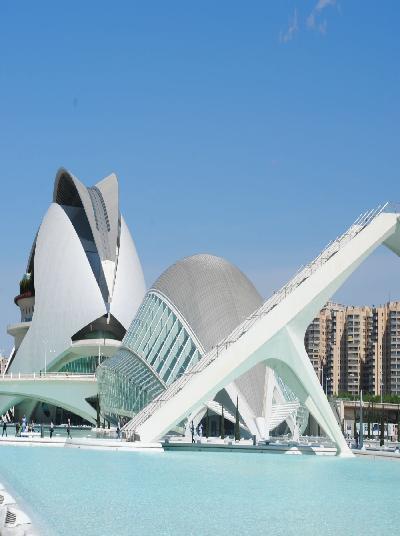 When visiting Valencia, you should not miss the opportunity to visit the largest cultural and entertainment complex in Europe and admire these futuristic works. In this place you can really enjoy the combination of art, science and nature.
When visiting Valencia, you should not miss the opportunity to visit the largest cultural and entertainment complex in Europe and admire these futuristic works. In this place you can really enjoy the combination of art, science and nature.
The City of Arts and Sciences complex was built in Valencia on the old bed of the Turia river by two world-famous architects: Valencian Santiago Calatrava and Félix Candela.
In 1989, the then Prime Minister of Valencia, Joan Lerma, took up the idea of José María López Piñero, Professor of History of Science at the local university, of building a science museum on the site of the Jardín del Río Turia. A team of specialists from similar locations in London, Munich and Canada was recruited for this.
The name of "City of Sciences and Arts" was given to the project by the autonomous government because it planned to build a 370-meter television tower, which later became the third tallest in the world, as well as a planetarium and a science museum. The total cost of the project was estimated at 25,000 million pesetas or 150 million euros.
In May 1991, the city council approved the transfer of the land, and 4 months later the City of Sciences' ready project, developed by Santiago Calatrava, was presented. In addition to the Spanish architect, Félix Candela, a Mexican, he also worked on the project.
The first buildings began to be built in late 1994 and on April 16, 1998 the City of Arts and Sciences was officially opened with the completion of the first building in the complex - L'Hemisferic Planetarium, which also houses the IMax Cinema and the Laserium.
The L'Hemisferic building is built in the shape of an eye and covers an area of about 13 thousand square meters.
Eleven months later, the President of Valencia, Eduardo Saplana, opened the Principe Felipe Science Museum, although it was not yet finished - the museum only opened its doors to the public 20 months later.
The building of this interactive science museum is shaped like the skeleton of a whale. It occupies about 40,000 square meters and is located on three floors.
L'Umbracle, another fascinating site of the City of Sciences, is a landscaped park with numerous specific plant species from this area.
There is also the so-called Paseo de las Esculturas, an open-air gallery with works by famous contemporary artists such as Miguel de Navarra, Francesc Abbott and others.
Also in the area of the City of Sciences is the bridge of El Puente de l'Assut de l'Or, which connects the south side of the City with Calle Menorca, where the 125 meter column is the highest point from the city.
L'Oceanografic, an open-air oceanic park with the largest oceanographic aquarium in Europe, occupies 110,000 square meters and contains 42 million liters of water on December 12, 2002.
The building was built in the shape of a jug and is the work of the architect Félix Candela.
The City of Sciences even has its own plaza - L'agora - where concerts and sporting events like the Valencia Open 500 are held. There is no doubt that all these architectural wonders make this place one of the most outstanding views in Spain.
The last building - The Palau de les Arts Reina Sofia - was inaugurated on October 8, 2005.
It has an opera house and a performing arts center. The building is divided into four large rooms: Main Hall, Aula Magistral, Amphitheater and Camera Theater, and is dedicated to music and the performing arts.
The construction of three other skyscrapers of 308, 266 and 220 meters high was planned in the territory of the City of Arts and Sciences ...
At night, the buildings of the Science City become skeletons of some inconceivable animals or fish.
The City of Sciences and Arts embodies the quintessential cultural and scientific side of life, making it a unique structure on the planet.
